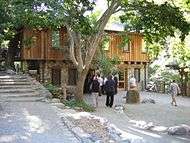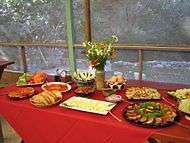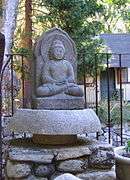Tassajara Zen Mountain Center
| Tassajara Zen Mountain Center | |
|---|---|
.jpg) Zendo at Tassajara | |
| Basic information | |
| Location | 39171 Tassajara Road Carmel Valley, CA 93924 |
| Affiliation | Soto Zen |
| Country | United States |
| Website | http://sfzc.org/tassajara/ |
| Architectural description | |
| Founder | Shunryu Suzuki |
| Completed | 1967 |
The Tassajara Zen Mountain Center in the Ventana Wilderness area of the Los Padres National Forest, southeast of Carmel-by-the-Sea, California, is the oldest Japanese Buddhist Sōtō Zen monastery in the United States. The Center is very isolated, more than 16 miles (26 km) from the nearest paved road, and only accessible via a narrow, steep, one-lane dirt road. During the winter months, practitioners live alone on site. During the summer months, the Center is opened to day and overnight guests. The hot springs have been developed into Japanese-style baths. It is the first Zen monastery established outside of Asia.[1]
History
The name is a corruption of Tasajera, a Spanish-American word derived from an indigenous Esselen word, which means ‘place where meat is hung to dry.’"[2][3]
The 126-acre mountain property surrounding the Tassajara Hot Springs was purchased by the San Francisco Zen Center in 1967 for the below-market price[4] of $300,000[3] from Robert and Anna Beck.[5] They improved the property and renamed it The Tassajara Zen Mountain Center, or Zenshinji (Zen Mind Temple),[6] during Shunryu Suzuki's tenure as its first abbot.[5] When it was purchased in 1967, it was the first Zen monastery outside of Asia.[1]
Tassajara is threatened by the 2016 Soberanes Fire, but has escaped damage. The Center is closed to guests for the remainder of 2016. [7]
Calendars and schedules
Practice periods
A practice period (ango in Japanese) denotes a period of intensive monastic practice. During the fall (September–December) and spring (January–April) practice periods, Tassajara is closed to the public. The rigorous schedule is a defining feature. Activity revolves around zazen (meditation), study, and work.[8]
Guest season
After the practice periods, Tassajara is open to the public from mid-April through early September.[9] For students, this period also allows them to earn credits toward the fall and spring practice periods. The guest season, with less rigorous daily schedules,[10] is a cornerstone of Tassajara's economic well-being.[6]
The guest program includes a major kitchen operation. Tassajara is renowned for its vegetarian cuisine.[11][12] Tassajara personnel also founded the Tassajara Bakery in Ashbury Heights[13] and Greens Restaurant at Fort Mason in the Marina District[12] in San Francisco. Edward Espe Brown's Tassajara Bread Book,[14] published by Shambhala Publications in 1970 and revised in 1986 and 1995,[15] is often credited as a major catalyst for the popularity of artisanal baking in the United States, while his Tassajara Recipe Book[16] is the best known of several books of general vegetarian cuisine produced by authors connected with the Center.
Gallery
See also
- American Zen Teachers Association
- Soto Zen Buddhist Association
- Retreat (spiritual)
- Timeline of Zen Buddhism in the United States
- Glossary of Japanese Buddhism
References
- 1 2 "History – Tassajara – San Francisco Zen Center". Retrieved 29 June 2011.
- ↑ Gudde, Erwin G. (2004). California Place Names: the Origin and Etymology of Current Geographical Names (fourth ed.). Berkeley, Calif.: University of California Press. ISBN 978-0-520-24217-3.
- 1 2 Janet Fullwood (November 29, 2006). "Serene escapes: Where less is more". Sacramento Bee.
- ↑ "INterview with Robert Beck". February 19, 2002. Archived from the original on February 15, 2009. Retrieved 29 June 2011.
- 1 2 David Chadwick (February 19, 2002). "Interview with Robert Beck". cuke.com.
- 1 2 Frederick C. Crews, review of Michael Downing's Shoes Outside the Door: Desire, Devotion, and Excess at San Francisco Zen Center (March 28, 2002). "Zen & the Art of Success". The New York Review of Books (abstract) reprint on cuke.com.
[The] book begins with, and then encircles in widening orbits, a conference held in March 1983 at Zenshinji, or Zen Mind Temple, better known to the world as Tassajara … Tassajara in summer sees too much traffic to be called a true monastery. Rather, it is part training camp, part profitable tourist enterprise, and part showcase for potential donors who may be inspired to support Zen Center's instruction in zazen.
External link in|work=(help) - ↑ Zen center News, "Because of the ongoing smoky conditions and the risk of fire, we have taken the difficult decision to close the Tassajara 2016 guest season". Accessed 9/8/2016
- ↑ San Francisco Zen Center. "Pure Standards and Guidelines for Practice Period" (PDF).
- ↑ San Francisco Zen Center. "Guidelines of Conduct & Precepts for Summer Practice" (PDF).
- ↑ San Francisco Zen Center. "Summer Work Practice".
- ↑ Alan Liddle (September 29, 1986). "Fresh seafood, produce mold 565 Clay's success – San Francisco restaurant". Nation's Restaurant News.
- 1 2 Eileen Hansen, review of Greens Restaurant (August 29, 2004). "It's good to be greens". San Francisco Chronicle.
- ↑ Peter Sinton (April 10, 1999). "Staff of Life Not Enough For Tassajara". San Francisco Chronicle (photo). External link in
|work=(help) - ↑ Ann Hodgman (March 30, 2003). "Flour Power". The New York Times.
- ↑ Brown, Edward Espe, The Tassajara Bread Book, 25th Anniversary Edition. Boston: Shambhala Publications, 1995. ISBN 978-1-57062-089-8.
- ↑ Brown, Edward Espe. The Tassajara Recipe Book, revised edition. Boston, Shambhala Publications, 2000. ISBN 1-57062-580-8.
External links
| Wikimedia Commons has media related to Tassajara. |
Coordinates: 36°22′12″N 121°35′27″W / 36.369956°N 121.590937°W
.jpg)
.jpg)

.jpg)
.jpg)

